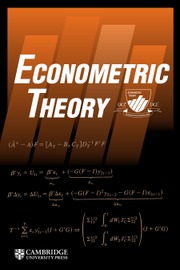No CrossRef data available.
Article contents
ASYMPTOTIC PROPERTIES OF THE GAUGE AND POWER OF STEP-INDICATOR SATURATION
Published online by Cambridge University Press: 06 November 2025
Abstract
Detecting multiple structural breaks at unknown dates is a central challenge in time-series econometrics. Step-indicator saturation (SIS) addresses this challenge during model selection, and we develop its asymptotic theory for tuning parameter choice. We study its frequency gauge—the false detection rate—and show it is consistent and asymptotically normal. Simulations suggest that a smaller gauge minimizes bias in post-selection regression estimates. For the small gauge situation, we develop a complementary Poisson theory. We compare the local power of SIS to detect shifts with that of Andrews’ break test. We find that SIS excels when breaks are near the sample end or closely spaced. An application to U.K. labor productivity reveals a growth slowdown after the 2008 financial crisis.
Information
- Type
- ARTICLES
- Information
- Creative Commons
- This is an Open Access article, distributed under the terms of the Creative Commons Attribution licence (https://creativecommons.org/licenses/by/4.0), which permits unrestricted re-use, distribution and reproduction, provided the original article is properly cited.
- Copyright
- © The Author(s), 2025. Published by Cambridge University Press
Footnotes
Comments from three anonymous referees are gratefully acknowledged. B.N. acknowledges support from the Aarhus Center for Econometrics (ACE) funded by the Danish National Foundation grant DNRF186. M.Q. acknowledges financial support by the David Walton Memorial Fund (Department of Economics, University of Oxford) and the Studienstiftung des deutschen Volkes.

